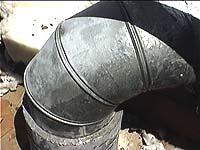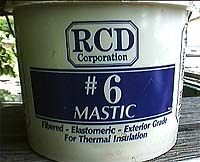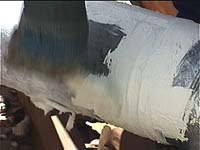 |
 |
 |
| |
 |
 |
 |
 |

When Heating, Venting, Air-Conditioning, & Refrigeration (HVACR) systems are installed in the common home, neither the location or position of the equipment is scrutinized. In some areas, it would make much sense to design the home around the HVACR ducting and equipment, but when older homes get newer equipment, it usually is tossed into the attic.
On a hot summer day, the attic temperature can reach 140°F
(60°C) when the outside temperature is some 95°F (35°C) primarily
due to solar radiant heating.  This
atmosphere is the worst possible place for HVACR equipment, whose job it is
to take the excess heat out of a home. Every effort must be made to seal and
insulate all attic equipment, most importantly the air ducts.
This
atmosphere is the worst possible place for HVACR equipment, whose job it is
to take the excess heat out of a home. Every effort must be made to seal and
insulate all attic equipment, most importantly the air ducts.
HVACR equipment usually delivers cool air in the summertime
at 65°F (18°F), a temperature difference of 75°F (42°C) with
respect to the attic! The same sort of temperature variations occur in the
winter, where warmed air may be delivered at 90°F (32°C) through an
attic at 20°F (-7°C). Two types of ducts are used in HVACR installations:
galvanized duct work held together with sheet metal screws and tape, or flexible
insulated ducts. Professional systems use the rigid metal ducts to reduce
constrictions of the pipes, and to deliver the air volume as planned. Flexible
ducting may collapse if not installed properly, but it is much easier to install
and use than metal ducting.
Wherever ducts mate with a air register or blower, mastic
or adhesive must be used to prevent air leaks. Mastic is a caulk type glue
that hardens into a tough membrane. Typically HVACR contractors use duct tape,
but this tape quickly breaks down under the great temperature changes in the
typical attic. Duct leakage may account for a large portion of the energy
bill, blowing cooled or heated air into hostile environments. There are several
manufacturers of mastic, but I used: RCD
#6 Mastic for my duct sealing.
If the duct work is installed properly, only small gaps will be visible when two pieces of material meet. If you find holes greater than 0.25 inch (6 mm), you should use a reinforcing fiber mesh, similar to drywall tape (you should be able to find the reinforcing tape where you buy the mastic). All surfaces should be clean of dirt, and then the product is troweled, brushed, or palmed onto the seams. Apply an adequate amount of mastic, and use two coats if necessary.
| Consulting | Digital Lifestyle | DVD Guide | Green Living | Building Hints | Product Tips |
| OS X updates | Free Newsletter | Pricing | Home | Contact | Site Map |
| Search | |||||
|
Copyright © 1997-2006 Green Building Concepts. All rights
reserved. Please click here for the Terms and Conditions of Use applicable to this site. Use of this site signifies your acceptance of the Terms and Conditions of Use. Direct all questions and comments about the web site to | |||||